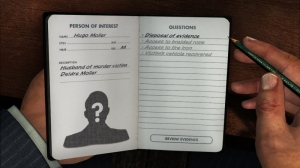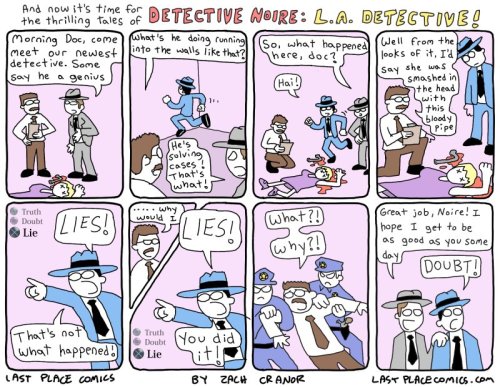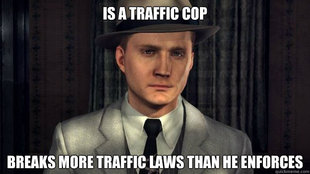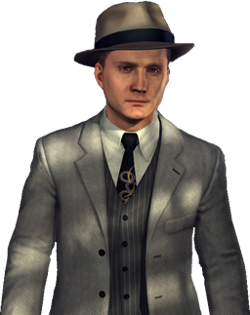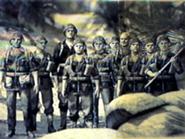Now that its all been said and done its time to close up this blog. After exploring the noir genre, Cole Phelps the central character, playing the game and its challenges and reading the game and body language. It can be said that this blog has wrapped around a good chunk of information and has analyzed and explored different options for readers. It is only recently that video games have been acknowledged as valid forms of narrative, and is not accepted by all. Although this game has been analyzed through the scope of narratology and speech genre, there is a ton of other ways to look at this game. So open a critical eye, turn on your gaming system and give it a whirl! This game is worth the play and once you understand the genre and learn to read the game you can be on your merry way! Happy Holidays everyone! Thank you for reading my blog!
Really well put!
Sir Walter Beck: “Does it ever feel like someone is playing games with you?”
Hero: “All. The time.”
I’ll start this one with an unquantifiable statement borne of my own personal opinion – Fable has always been a highly controversial game series. Not so much through it’s gameplay or story – those have always been quite entertaining – but through a repeated tendency by the series’ developers to advertise somewhat…overexuberantly. Because of this, the series has been examined consistently, and reviews of it have swung in multiple different directions vis-a-vis popularity and entertainment value.
So, now that that’s been said, the reason I’m stating this is to simply get it out of the way. I am registering my awareness of Fable’s status in the gaming industry and amongst the consumer base, and I would like to state for the record that said controversy does not have any bearing on this…
View original post 1,351 more words
Posted in Uncategorized | Leave a Comment »
Video games are a complex collection of signs and symbols that communicate a narrative to the player. The creators of this game in particular created a very realistic representation of the human form and its movements, including facial expressions using new technologies (as seen in my last post). The player is expected to be able not to just play the game, but read it and make sense of what the objectives are. In L.A. Noire players are expected to go above the regular game play and actually read human body language communicated through the game.
There are three angles of narration, the narrators, the focalizers and the actors. Who sees and who speaks? We as the player see through Cole Phelps’ perspective in the game which could also be considered the narrator. Although the player only knows what he tells us and what appears in flashbacks, so it could be said that Phelps is the focalizer of the game and the narrator is a 3rd person omniscient narrator that only gives the player little bits of information and expects us to follow through with the game to get it all. The actors are the game characters, the ones that are suspects, ones that are witnesses, anyone who Phelps has to talk to, to get information. So who speaks? Phelps speaks to us through his notebook. The notebook is a very important object in the game:
The notebook provides the player with everything they need to know about a case. Phelps communicates all his knowledge in this notebook and allows the player to interpret what fits and what doesn’t. The key to beating the game is to read the notebook in relation to what type of body language the suspect or witness is giving off.
When interrogating someone in this game it is crucial to pay attention to how they behave. Watch their eyes the most, the hardest part is that a lot of the actors lie differently. The key is to understand the genre and how the game operates. For the truth, the actor is looking right into Phelps’ eyes, they do not stutter and they do not tense. The harder ones to differentiate is doubt and lie, although there is a simple way to decide. If accusing someone of lying evidence is needed to prove the lie, so check the notebook to see if there is proof and proceed. Otherwise its safer to assume it is doubt and go in that direction. In both cases the actor is lying but if the player chooses to doubt them and it works they are not very good at it, and often crack under the pressure and tell the truth. The easiest way to tell if they are being untruthful is too look into their eyes, they often will refuse to look at Phelps and might tense up and look away. Another problem is missing clues, in order to get someone that is lying the player needs to make sure you have collected every clue possible to prove that person is lying, and sometimes you might accuse the wrong person.
The importance of body language in this game is crucial. To understand how to tell if someone is telling the truth, doubtful or lying is actually a lot more difficult then you would think. The first case is pretty hard but after the player gets the hang of it its gets easier until the actors get better at convincing you they are not lying. So make sure there is evidence to prove the point before trying to question anyone.
Posted in Uncategorized | 1 Comment »
This form of narrative has built the story into a video game. The creators supply the player with the narrative and the means to discover it by playing through the game. The game communicates the narrative to the player interactively using components such as sound, physical, textual and most importantly visual. Sounds include everything from background effects, to music, the quest music and voice over. The background effects are things like gun shots, car noises, rain, wind, foot steps the list can go on and on. These effects make the narrative come to life, where description would be in a textual narrative there is background effects in the game. The music has been chosen specifically to represent the time period and to help the player get into the noir genre. The quest music is an interesting tool to help the player look for clues, the music means they are expected to look for things until it stops. It will make a small noise when you are at an object you can pick up, and Phelps will tell you if it is relevant or not as you change the focus of the camera to look at it fully. When all of the clues have been found the crime scene music will finish and you know it is time to move on. Voice overs also indicate what the player is supposed to do using the voices of the characters. An interesting part of this form of communication to the player that everything that is said is recorded in the logbook, and you can go back and look at it if you wish to. Also you can have subtitles appear while playing through the game, having sound and text starting to interact. The following video is just crime scene or clue finding music from the game:
The physical aspects of the game are all on the player. Everything you have to work for in the game is controlled by the player, and this enables the player to communicate directly with the narrative. The physical element of the game takes it above film and text because you literally control what your character does whether or not you control the narrative. Although sometimes the player could do something they really shouldn’t be doing in the narrative. For instance, the following is a comic about how the player can completely make a fool of themselves and it goes unnoticed in the game world, taking a little bit of the realism from the game:
Although, if a player is to convict the wrong person they generally either make you try again or they make you start all over again. The single hardest part of this game and controlling it, is driving. Driving is absolutely brutal, sometimes when you find a sweet hidden car its a little easier but it is pretty embarrassing when you hit a bunch of people and I once actually totaled my car to the point it caught on fire. The following is a lovely example on how well driving goes over in this game:
The text based portion of the game interacts with the voice overs in most cases. Although there is some parts of the game that are not read out loud and you can read them to further understand the game. For example, reading over the notes you find in some of the cases that the victims have with them from their parents. If you don’t read them there can be some confusion with what happened to them, and sometimes they lie to you about their situations so the only proof is what you know is in the letter. Another example of textual content is the map, you use the map to locate yourself in the game and where you want to go. Without reading the map there are some quests you will have trouble with and it will take a lot longer to find all the hidden content (cars and landmarks). The text based part is really only secondary to the sound based part because so much of it is read out loud to the player anyways.
The visual part of the game is the most important to the entire narrative. The visual brings all other aspects of the game to the surface, it uses colours, sets the tone and mood, brings out the genre, gives the player a more concrete way to see this time period and the genre it comes from.
Everything the game is representing to the player is specific to the noir genre and is supplying the narrative in a very real way but guiding the player through the genre to make more sense. If one is to just watch film to understand the genre it could take longer, text based does not supply the same effect either because so much is left to interpretation and imagination. This video game is bring literature and film together to create an interactive noir themed game that allows players to understand the genre more fully and be rewarded for their efforts. All the effort a player puts into the game gives them more of the narrative and an understanding of the genre itself.
Posted in Uncategorized | Leave a Comment »
“Friends who want to stay friends, don’t discuss religion or politics. In my case, you can add the war to that.”―Cole Phelps to Ralph Dunn
Cole Phelps is a WW2 veteran and a rookie traffic cop in the beginning of the game. Phelps acts as your guide through not only the game but the noir genre. The player is given little information on Phelps, but from the knowledge of the genre itself it becomes clear where this man’s story is going to go. (See Noir as a Genre) The only information we are given on Phelps, is that he is a WW2 veteran (known from flashbacks), he has a wife and kids and that he is a police officer. Phelps is a mysterious character just like any other noir detective in the genre.
As the game progresses Phelps changes, he becomes more hard-boiled with every case like the detective’s from the films. Phelps goes through the motions, sticking with the rules and he himself is guided through the game by a partner. The idea of playing this game with him as your guide is interesting. You control his movements but he is of his own mind in the game. The player is simply trying to understand the genre and is being rewarded for doing it correctly by receiving more of the narrative (Phelps’ past) and more privileges like new cars and cool new suits and a higher position in the game. The key is understanding the genre and understanding Cole Phelps whose character is not always going to do the right thing. Rarely the player gets choice in the game, unless you want to fail the case and be stuck trying it over and over forever. When you do have choice it usually involves whether or not you plan on tackling the running hostage or shooting him dead. Phelps does not give the player options, he guides the player through his narrative using the genre that the player is expected to learn. There is nothing the player can really do to change the narrative, the story is set and Phelps is in charge. The reason this game becomes so interesting is because we as a player want to know the story and enjoy going through the motions.
I do not want to give away too much information, plot wise in the game. Although Phelps is most certainly victim to all the conventions of the noir genre, including the femme fatale aspect of the game… even though he is married and has too unnamed daughters. Corruption is becoming a huge part of Phelps’ character, he is slowly but surely becoming someone else. Maybe it is because of what happened in the war, maybe because of what is happening to him during his job. Phelps’ is already a mysterious figure but he does say how much he loves his family in the beginning of the game… then they just sort of stop getting mentioned… hmmmm… taking work home with him maybe? It is especially understandable that his job is getting to him when he moves up into the homicide division. This is a pretty graphic game (not going to lie I felt ill during the Black Dahlia Case) there is literally no way this man is not affected by what he sees in the game and if the player keeps a close eye on him they will notice as he progresses into a different character entirely. Phelps really does fit into the noir genre flawlessly like the game makers wanted, all the conventions and aspects will be portrayed in the game from Phelps to the music and narration of the game.
Spoiler Alert, only read this if you want to ruin the game for yourself! (Cole Phelps)-very in depth character overview.
Posted in Uncategorized | Leave a Comment »
L.A. Noire is based on the hard-boiled (meaning tough or unsentimental) detective genre known as film noir of the 1940’s. Film noir (dark cinema), is a variation of the French term roman noir (dark novel), about lowlife criminals also related to séries noire (dark series) which is what Parisan publishers new line of grim thrillers and violent detective stories are known as, most of them American in origin. These films are derived from the novels most of which were written by Hammett, Chandler and Cain such as, Hammett’s Maltese Falcon, Cain’s Double Indemnity and Chandler’s Big Sleep. These came out on film during the second world war and were filled with pessimism, cynicism and darkness. They dared to take a harsh, uncomplimentary look at American life at this time and comment on it through film and novel. This pessimistic view of the human condition grows from the disillusionment spawned by WW2 with its massive casualties, genocide, torture and atomic clouds. (Philips)
The noir genre has a series of conventions, like femme fatale (the alienated and doomed anti-hero determined to do away with her husband), flashback voice overs and a shadowy sort of black and white look. (Conard & Porfirio) Including the use of dark angels, elongated shadows, rain glistening on windows and windshields and faces are barred with shadows that suggest the imprisonment of body or soul. This dark, brooding atmosphere, coupled with an equally somber view of life mark a movie as film noir. (Phillips)
Film noir pushes at the boundaries of classical narrative. It rejects traditional narrative patterns and is fundamentally about the problems of of seeing and speaking truth, about perceiving and conveying sense of our culture’s and our own reality, problems of truth and objectivity. (Conard & Porfirio)
This genre has been changing over time and can still be seen today. The first type, the classical detective or sleuth, was introduced by Edgar Allan Poe in the 1840’s with his hero Dupin, and was present on movie screen in the 1930’s-40’s in detective series. In American detective fiction of the 1920’s and 30’s the sleuth gave way to the private detective fiction of the hard-boiled variety created by authors like Raymond Chandler and Dashiell Hammett, who made it onto the screen in soft-boiled versions in the 1930’s and hard-boiled in the 1940’s film noir. The street-wise solitary detective of the hard-boiled story, however, was replaced by the police detective of the procedural by the 1940’s. The 1950’s saw the hero as neurotic and often corrupt, the late 60’s and into the 1970’s a violent vigilante hero, the 1970’s and 1980’s a return to a noir-hero, 1980’s a cop-action hero. Even thorough the 1990’s-2000’s an educated, intelligent, middle-class criminalist, for example, Booth played by David Boreanaz in Bones could be identified with this description. (Gates)
The genre is in a nutshell about a detective with a mysterious past, shown through flashbacks, that is working during the 1940’s trying to solve cases and make a name for themselves. These characters are often depicted as corrupt, alienated, violent, pessimistic, cynical and in search for truth. The conventions of the genre include femme fatale, flashback voice overs, dark black and white sort of feel to it. The genre is classified as something unique to this time period, it has a different narratology and a different speech genre and patterns. In L.A. Noire the player has to learn the genre and learn how to play it, including the different language and expectations of the character guide in the game.
Posted in Uncategorized | Leave a Comment »
Welcome to my blog! I am a 3rd year university student at Trent University in Oshawa, and I am going to be using narratology and speech genre to discuss the game and the central character Cole Phelps in my blog for my Critical Approaches class. The game is set in 1947 Los Angeles, where Cole Phelps, a second world war veteran, starts out as a rookie police man. Here is a video which further explains the game:
Now that you have seen the awesome video and I have your attention. I’d like to point out that the game is full of different speech genres, ones that you as the player has to learn fast to understand the language being used and apply it to the game. Everything from body language to police terms, the player is put into a different culture, time period and genre. For further understanding of the “detective noir” genre we can turn to films (a more exciting approach for sure!) or novels (which are also enjoyable).
Posted in Uncategorized | Leave a Comment »

